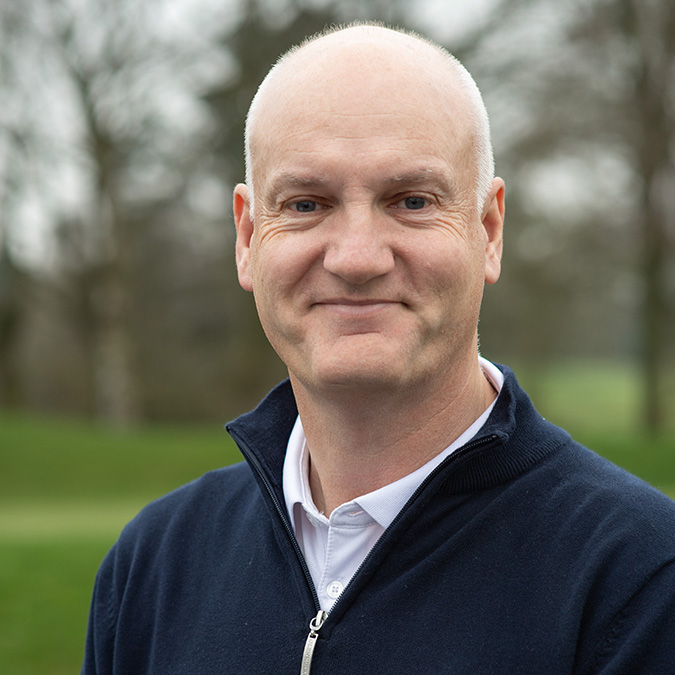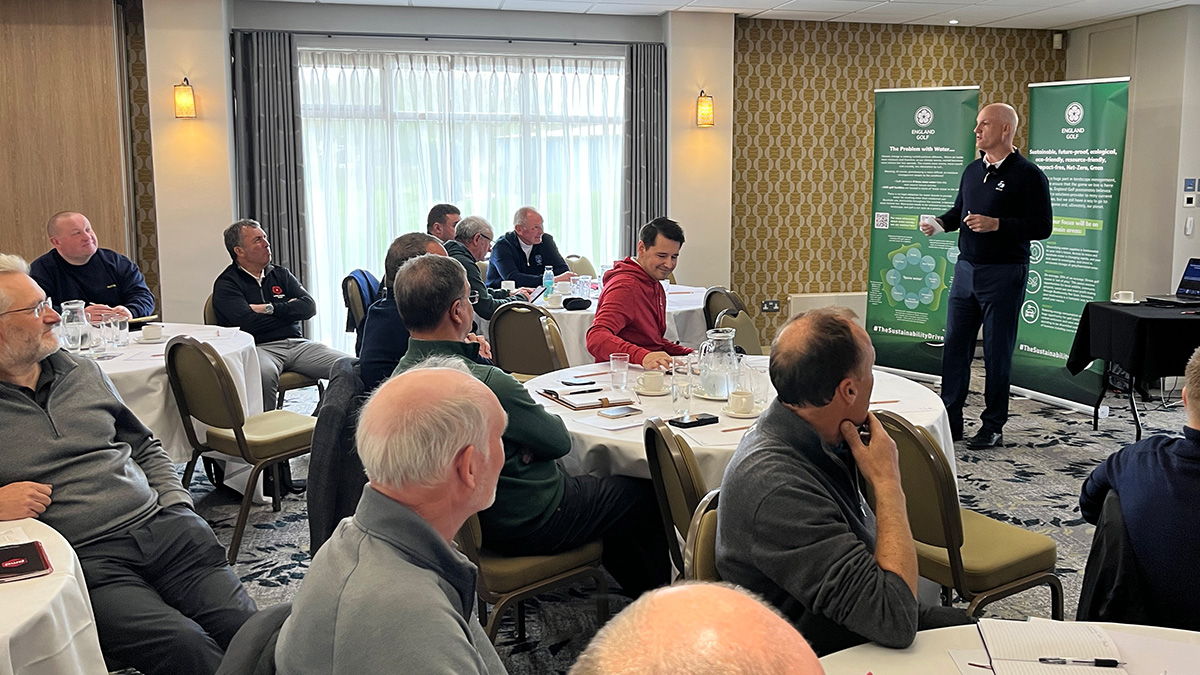- Homepage
- News and Features
- BLOG: 'If we make golf courses good places to work, staff will pass that goodwill on to customers'
BLOG: 'If we make golf courses good places to work, staff will pass that goodwill on to customers'
As part of our commitment to championing the role of greenkeepers towards the ongoing health of the golf industry, BIGGA representatives have spoken at various public engagements over the past few months.
Among other events, during February, March and April BIGGA CEO Jim Croxton has represented the association at regional England Golf Governance Roadshows, the FEGGA Conference in Madrid and the Golf Forum in St Andrews.
Jim was also recently asked to speak at an England Golf Sustainability Conference, hosted in partnership with the Cheshire Union of Golf Clubs at The Tytherington Club.
Below is a transcript of his talk, with key points including:
- Public perception of golf
- Governance in golf clubs
- Golf as a form of land use
- Resource availability
- Robotic technology
- Community outreach including First Green


Jim Croxton, England Golf Sustainability Conference, The Tytherington Club, 23 April 2024
It's great to see so many people here today. We’re always keen to be involved where people from the golf industry gather, because we think our members have a really important role to play. Looking at the list of people in attendance and we’ve got the R&A and England Golf, the people in England charged with running this sport that means so much to everybody. We've got club managers, club chairmen and board members, people whose key responsibility in life is to run a successful golf club.
We've got greenkeepers, who we all know for 24 hours a day, seven days a week are passionate about their golf course. Many of those are in a desperate mental state because of the last few months. To hear Owen [James, England Golf] say 250% of our average winter rainfall has fallen these last few months, it's just soul destroying. But it’s heartening to see our community of greenkeepers doing their best to keep each other’s spirits up.
We've also got some golfers here who just want to get out there and play. We have pesticide salesmen, who play an important role in the supply chain for the golf industry. And we’ve got the Environment Agency, who we need to work so closely with because we're a big user of land and what we do on our land has a big impact on the rest of society
I think everybody who comes to a sustainability seminar has something in common. We all want to find out how we can make our sport, our business, our golf course, our piece of land, more sustainable and hopefully, we're all united in this ambition.
BIGGA was formed in 1987 following an amalgamation of an English association, a British association and a Scottish association and today we have around 6,000 members. The majority are greenkeepers in the UK, although we have several hundred overseas members, and we also have around 800 affiliate members. We've got pretty good coverage across the country, but we're not perfect and we have lower membership at the lower budget golf clubs. This is an area of concern for us and something we're looking at because often it's the very low budget golf clubs where greenkeepers need the most support and help. We're not a union, but we do our best to help our members when they need us.
The thing I'm most proud of is how committed our members are to education. We launched the first CPD system in golf and we have thousands of members engaged each monthly with that.
First and foremost, the responsibility of the association is to look after our members.
Secondly, we try and support the game, because if the game is in a good state, that's got to be good news for our members.
And thirdly, in the last 10 years the collaboration across our sport has grown. We work much more closely with The R&A, England Golf, Scottish Golf, Wales Golf, Golf Ireland and others and we feel it’s our responsibility to show leadership in our side of the industry, and sustainability is a crucial part of that.
Public perception
Within ecology, our members have been at the forefront of driving biodiversity and supporting pollinators. There are two reasons: it’s good for the environment and they feel it’s the morally the right thing to do, and the other is it often reduces the operating costs of the golf club.
A few weeks ago, my colleague Karl [Hansell], who runs all the communications for BIGGA, was contacted by a journalist for The Daily Telegraph. Pretty big deal. And this journalist is a science correspondent with a particular interest in the environment. He said he’d heard about a golf club in Denver, Colorado, that had started rewilding areas of the course, and whether we thought it could be something golf courses in the UK would ever think of doing. He thought that was the first golf course in the world to actually do some rewilding and put some do some work to improve the environment.
Karl’s quoted towards the end of the article and even after we explained just how many hundreds if not thousands of golf clubs across the UK are doing work day in, day out to improve biodiversity, habitats, water efficiency and waste use, they still led with ‘This golf course could be the first in the world to be doing something for society’.
It's fascinating because there are 5.2 million golfers in the UK today. If you ask golfers what they think about our sustainability credentials, it's about three times better than non-golfers. What we've got to look at is how others perceive us. We’ve got to get our own house in order, absolutely, but it’s important to see what the world thinks of golf.
Governance
Golf is a unique sport. The R&A and England Golf are the governing bodies in England but they don’t tell us how we run our businesses and our golf courses. They tell us what clubs we can use, what balls we can use, what the rules are, and they've sorted out this incredibly modern and difficult-to-understand world handicapping system that allows me to play with my mother-in-law and my child, which is one of the great things about golf.
I'm a football coach at the weekends and the way I run my son’s under 18 boys’ team is entirely determined by the FA. They tell me how many times those kids can head a ball in training, they tell me the exams I've got to take to be a coach and I’ve got to stay up to date in all manner of things. With respect, we don't have any rules in place or exams people must take to become club chairman or sit on a golf club’s committee.
Golf is a sport that's run by the facility. If we put our employees first and we take care of them by making golf clubs good places to work, they will pass that goodwill on to the customers. Golfers will get a golf course that they enjoy playing and we will hopefully be seen by the wider public as a better use of land and resources, so hopefully golf will be thriving in 50 years’ time.
Golf as a form of land use
The game of golf is changing. Two or three golfers are playing ‘off’ course to every one golfer playing ‘on’ course. There are 15-20 million people who are consuming golf, through driving ranges, Top Golf, adventure golf, golf simulators and other creative means, compared to the 5 million that play golf on a course. So, this is not just about golf courses, it's about the entire golf environment, because most of them take up some space.
Golf in England accounts for 1% of our land use. We’re a small island with growing population pressure and land use is really important. We're members of the All-Party Parliamentary Group for Golf and every month we have a meeting that starts with mentions of golf in Parliament. There are on average four or five mentions of golf in Parliament and almost all are an MP saying we should build housing on the golf courses in our town.
The pressure externally is for us to give over our golf courses, but the data that is being gathered proves they are great for biodiversity and habitat creation, so golf courses have a key role to play in sustaining the natural world, which in turn supports the human population. Our carbon footprint is reducing to the point where at some point in the relatively near future, we will be one of the better uses of land there is in the country. But externally, when people think golf, they think diamond jumpers and manicured fairways that can be paved over. That's a big problem and we're going to have to defend our land use. We'll lose some battles and hopefully we'll win others as we as we move forward.
Resource availability
You may be aware of the pressure that came in from the EU in the last 12 months about banning all pesticides in the amenity space. That's gone away for maybe two years, but we will soon see a further reduction in our access to the chemical or biological solutions that we have. I don't think it means they'll disappear in this country, but it's going to get harder and more expensive to access them.
We're going to have to do some of those suggestions that all those incredible reports Golf Course 2030 have produced. We’ve got to read those and look to be more robust against regulations when they come in.
The government can take chemicals away from us and just say ‘sorry, it’s not important enough’. Golf Course 2030 is critical because it helps us plan our route to a more sustainable future. We can look at where we are, what our problems are, whether we need to improve our grass species or if we’re too reliant on a particular resource and Golf Course 2030 gives us a roadmap of how to complete that journey.
Robotic technology
Increasingly, we’re seeing robotic technology being introduced to the industry. Will robots mean fewer greenkeepers? Perhaps. Will it mean fewer qualified, educated greenkeepers? I don’t think so. There will still be a need to cut grass, but we’ll also need more agronomists and trained equipment managers. We’ll need ecologists, irrigation and drainage specialists and we’ll need robot operators and drone pilots, so greenkeepers will become better qualified, with areas of expertise that are respected by the wider community.
The role is changing, but we're going to need people because without people, we can't run our golf businesses. Greenkeepers, club managers, volunteers, owners: all are critical to making sure our golf business understands the sustainability challenge and moves forward with it.
Community outreach
I want to talk about one final thing that we're doing and which we're really excited about. First Green is an American initiative that we have licensed from the GCSAA, which brings schoolchildren into golf courses. It's really popular with schools, which are desperately keen to expose their pupils to science, technology, engineering and mathematics opportunities in the real world, which leads on to children exploring those options as careers choices.
We know that greenkeeping is an invisible profession. If you ask greenkeepers how they got into the job, it’s usually a family connection, they played golf as juniors or it was by accident and they just knew someone who mentioned they were on the look out for greenkeeping staff.
But if we are to thrive, we need to drive people into our clubs. The golf industry is a £10 billion industry in the UK, creating 100,000 jobs, so it's a big deal. But there isn't a pipeline for people coming into the industry, and that needs resolving.
Additionally, is your golf club the sort of place where you’d welcome kids and their parents or teachers to come and see where your team works? If not, then you might want to look at your facilities and see about improving those. That way that little Johnny's mom, when she comes in, she doesn’t say ‘well, you're not working here!’ and take him off to work somewhere else.
We've got to start seriously considering how important our staff and our volunteers are to the industry, and treating them with the respect they deserve.
We're committed to First Green. If you haven't heard of it, go on our website, have a look and get in contact with our project leader, Jenny [Bledge].
In conclusion
I think we have some great opportunities. We need to start thinking about how we are viewed externally, which means engaging with your local community and media, such as newspapers. There are great stories to tell about ecology, habitat creation and biodiversity.
There is also a massive opportunity for us to conserve our resources better. I won't speak for the Environment Agency, but I know government organisations are looking at our use of resources and they want to see an industry that is doing what it can to look after those resources better, whether it be water, carbon, sand, fuel use.
The other opportunity we have in front of us as greenkeepers is to look at our grass species selection to help reduce the inputs required to create a playing surface. Then, we need to communicate how difficult that change is so golfers understand the journey your club needs to go on, to be more sustainable in 10 years’ time.
Taking your members with you on that journey is crucial because in the end, the job of the greenkeeper is to try and prepare the surface for golfers to be happy. If that isn't happening, it's a pretty tough job to have.
We want to hear from you. How are we doing? As a BIGGA member, do you feel you're getting everything you need from the association? Get in touch with us, either by contacting BIGGA HQ or speaking with your local representative. Contact details for the team are here.
Author

